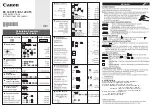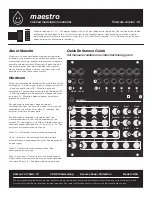
17
© Oz inventions
Version 1.8
Bidirectional switch
The bidirectional switch is a permanent toggle switch. It is actuated by pushing it backward. It enables
modulation output in two directions. Modulating output will normally decrease from 127 to 0 and there will
be no further change should the sensor continue below the 0 point. With bi-directional selected, the
modulating output will continue to be present in the negative direction. -127 - 0 – 127 . In rotation and guit-
hand mode the bidirectional switch enables a continuous sweep.
Sensitivity control (0 – 99)
The sensitivity control has different functions depending on which modulation mode is being used.
Tilt mode
The sensitivity control adjusts how quickly the modulator responds to received data from a sensor, and how
stable the modulated output is. The control is a compromise between response and stability. Great stability
comes with a slow response time. Quick response times are less stable. Either condition is not a hindrance,
but rather can be used to good effect. For example quick response and low stability enables quick
movements to produce warbling effects, whilst slow response and high stability enables robust player
movements so that modulation only occurs at specific points. A slow response can also be used to provide a
delay which gives a pad type string effect as modulation slowly increases and decreases.
Knowing the exact position of the sensitivity control is not always needed, however its level is briefly flashed
on the screen whenever it is moved. Fully anti-clockwise = 0. Fully clockwise = 99.
Quad tilt mode
The sensitivity control adjusts the point where the modulated output effectively
has a value of zero. With the control at ‘0’ (fully anti-clockwise) the zero point is
where it is expected to be, directly after or before ‘1’, depending on which
direction the 4-way mode is tilting.
As the sensitivity control is moved clockwise higher values also begin to have a
value of zero. This gives a point of rest for the user because without this space
there would always be some modulation as the user quickly crosses over the zero
point.
The sensitivity control in quad tilt mode also enables effective retriggering of the
ADSR envelope. The zero point is needed for retriggering and is difficult to locate
when there is only a small zero point window available.










































